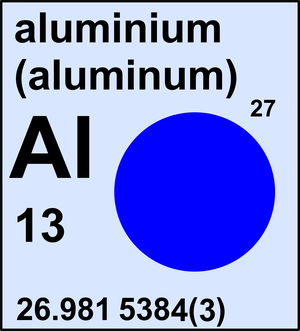Aluminium
| Isotope | Atomic mass (Da) | Isotopic abundance (amount fraction) |
|---|---|---|
| 27Al | 26.981 5384(3) | 1 |
Aluminium is a monoisotopic element and its atomic weight is determined solely by its isotope 27Al. The Commission last revised the standard atomic weight of aluminium in 2017 based on the latest Atomic Mass Evaluation by IUPAP.
26Al is radioactive with a half-life of 0.705(24) Ma, too short for survival of a detectable amount of primordial isotope. However, 26Al is recognized as a spallation product of argon from cosmic rays. In addition, secondary cosmic rays including muons interact with Si-bearing rocks to produce 26Al in measurable amounts, but far below levels that would affect the atomic-weight value in normal materials.
27Al is the most abundant isotope in the earth's crustal rocks with an uneven atomic number.
© IUPAC 2003

CIAAW
Aluminium
Ar(Al) = 26.981 5384(3) since 2017
The name derives from the Latin, alum and alumen for "stringent" because the early Romans called any
substance with a stringent taste alum. The element was known in prehistoric times. In 1825, the Danish
physicist, Hans Christian Oersted, isolated impure aluminium. The pure metal was first isolated by the
German chemist Friedrich Wöhler in 1827.


